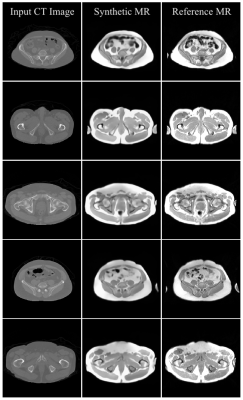Reza Kalantar1, Jessica M Winfield1,2, Christina Messiou1,3, Dow-Mu Koh1,3, and Matthew D Blackledge1
1Division of Radiotherapy and Imaging, The Institute of Cancer Research, London, United Kingdom, 2The Royal Marsden Hospital, London, United Kingdom, 3Department of Radiology, The Royal Marsden Hospital, London, United Kingdom
1Division of Radiotherapy and Imaging, The Institute of Cancer Research, London, United Kingdom, 2The Royal Marsden Hospital, London, United Kingdom, 3Department of Radiology, The Royal Marsden Hospital, London, United Kingdom
With the advent of the MR-Linac automatic pelvic MR segmentation is becoming essential to plan radiotherapy treatments efficiently. We developed a deep learning-based model to generate synthetic T1W MR images from pelvic CT to enhance datasets for automated MR segmentation development.

